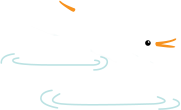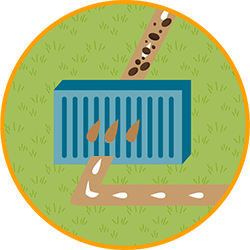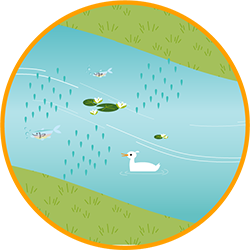



Rain lands on hard surfaces like roofs, driveways and parking lots.

Water flows into storm drains, picking up oil, soap and other pollution along the way.
Sometimes it flows into a swale or rain garden where water is slowed down and filtered through plants and soil.
Some water, called groundwater, soaks into the ground and is stored to use later for drinking and to water crops.

From the storm drain or swale, water flows to the nearest stream and eventually to the Tualatin River.


Water from the river gets pumped out and cleaned at a drinking water facility.

From there, water is pumped into homes and businesses to be used for drinking, washing and making the things we use every day.

After we use water, it flows down drains through pipes to a treatment and recovery facility.

Before we start cleaning the water, large debris and garbage like cleaning wipes, straws and q-tips are taken out and sent to the landfill. After the screen we slow the water down enough to allow heavy material like gravel, grit and sand to settle out before water moves on to primary treatment.

Water is pumped into large tanks where it becomes nearly stagnant, or hardly moves at all. This allows anything denser than water to settle (like human waste and toilet paper) and anything lighter than water to float (fat, oils and grease). Rotating arms push these solids to pumps that send materials to our solids handling facilities for resource recovery.

The aeration basin is home to tens of thousands of pounds of naturally-occurring microorganisms, which you could find living in pristine mountain streams or healthy soils. The microorganisms are happy to consume and metabolize the organic material they find, but we closely monitor their environment, food supply and population. After metabolizing their food, the mix of microorganisms and water overflow into secondary clarifiers where they are separated by gravity. To save energy, we only keep enough microorganisms to get the job done, which means constantly monitoring the population and sending the extra to solids handling.

The next step is a lot like the process to clean drinking water. There are still some very small solids and dissolved phosphorous that we need to remove. Alum and polymer are added to the water and become a solid that fine particulates stick to. As the mass gets bigger, it also gets heavier and sinks to the bottom of the clarifiers before moving on to solids handling.

We use several feet of finely graded sand that water passes through to remove leftover chemical solids and very fine particulates that didn't settle in the previous step.

We add a small amount of chlorine (less than a swimming pool) to kill any pathogens. Before sending water to the Tualatin River (or reusing it for irrigation) we make sure it is safe for wildlife and people by removing the remaining chlorine with sodium bisulfite. The cleaned water is returned to the Tualatin River to be used again.

Cleaned water from our facilities nearly meets drinking water standards. While most of our cleaned water is released into the Tualatin River, our water is also used for irrigation at local schools, parks and golf courses.

We recover and reuse several nutrients through the treatment process. Solids that settle out during primary and secondary treatment are routed to digesters where they are heated and mixed for about a month, resulting in 31 dry tons a day of nutrient-rich biosolids that are used as a soil amendment on local farms and rangeland. Our larger facilities process phosphorus and other nutrients into a slow-release fertilizer.

Cleaning used water takes a lot of energy, but we generate some of our own from renewable sources (cogeneration of fats, oils and grease and methane gas from our digesters) and from solar panels. We meet about 37 percent our electricity needs through these methods.


If water doesn't get drawn out of the river and used for drinking or irrigation it evaporates to start the one water cycle over again.
Underground in Washington County more than 800 miles of sewer pipes carry wastewater to one of our four treatment facilities. We use gravity to move the water wherever we can, but sometimes water needs a lift from pump stations to get over a hill and let gravity take over.
Before we start cleaning the water, large, solid materials like wipes, rocks and q-tips are taken out and sent to the landfill. After the screen we mix water to remove any grit and sand-like material before water moves on to primary treatment.
Water is pumped into large tanks where dirt, gravel, and other heavy material settle to the bottom and grease, oil, and other light materials float to the top. Rotating arms remove these pollutants and they are pumped into digesters and recycled into biosolids.
Next, we use microorganisms to continue cleaning the water. The microorganisms are happy to eat the remaining waste but we keep a close eye on them to make sure their environment, food supply and population are healthy and productive. After gorging themselves on incoming waste, the microorganisms process their meal in settling tanks. Some will go back to eat more, while others are sent to the digesters to become biosolds.
*More than 98 percent of the nation's wastewater treatment facilities only provide secondary treatment. However, the slow, sensitive Tualatin River needs very clean water to be healthy.
In the next step, we use chemicals and bacteria to remove as much phosphorous from the water as we can. If there's too much phosphorous in the Tualatin River, algae grows quickly and sucks oxygen out of the water which is needed by fish and other living things.
In the last step of the process we add a small amount of bleach to the water to kill any remaining bacteria. Before sending water to the Tualatin River (or reusing it for irrigation) we make sure there is less than (XXXppm) of chlorine which could harm wildlife.
